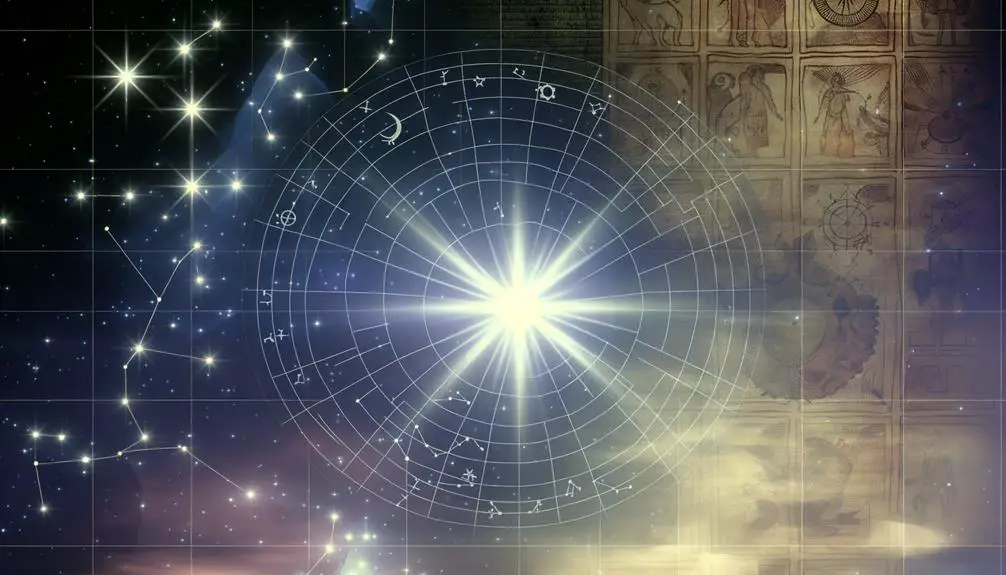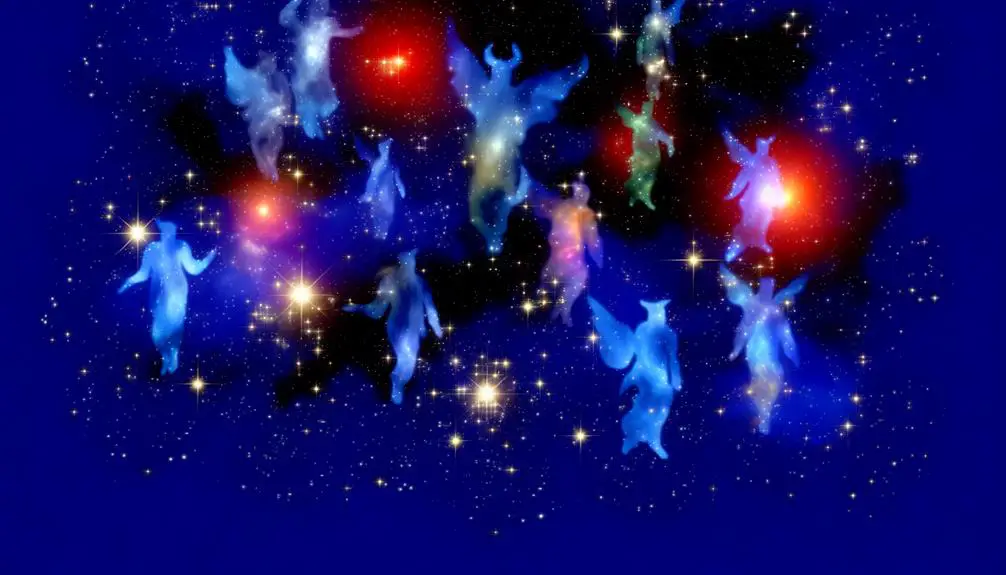Understanding the Symbolic Meaning of Stars Across Cultures
Stars have symbolized guidance, divinity, and cosmic mysteries throughout history. In ancient civilizations, stars were used for navigation and calendrical systems, often embodying celestial deities in mythologies.
Religiously, stars represent divine presence and spiritual illumination across Christianity, Islam, and Judaism. In literature, stars explore themes of hope, destiny, and existential reality.
Artists have depicted stars to convey inspiration and human ambition. In modern culture, stars are iconic symbols in contexts such as fame, scientific exploration, and motivation.
To uncover the nuanced interpretations and historical roles of stars, a deeper exploration reveals a rich tapestry of meanings.

Key Takeaways
- Stars symbolize divine guidance and spiritual illumination across various cultures and religions.
- In literature, stars represent hope, destiny, and the human experience, linking the mundane with the cosmic.
- Historically, stars served as celestial guides and omens in ancient mythologies and civilizations.
- Stars in modern culture convey fame, scientific curiosity, and positivity, seen in contexts like Hollywood and digital communication.
- Artistic depictions of stars explore themes of divine inspiration, existential wonder, and human ambition.
Historical Significance of Stars

Throughout history, stars have served as profound symbols in various cultures, representing guidance, divinity, and the mysteries of the cosmos. Ancient civilizations, such as the Mesopotamians and Egyptians, meticulously charted stars to develop early forms of astronomy and navigation.
Stars also featured prominently in mythologies and folklore, often embodying deities or celestial narratives. The Greeks, for example, associated constellations with mythological heroes and creatures, embedding astronomical observations within cultural lore.
Similarly, the Chinese developed sophisticated star maps, intertwining astronomical data with astrological and imperial significance. These historical engagements with stars reflect humanity's enduring quest to understand the universe, revealing a complex interplay between scientific inquiry, cultural expression, and existential contemplation.
Stars in Religious Contexts
In religious contexts, stars frequently symbolize a guiding divine presence, as seen in the Biblical Star of Bethlehem that led the Magi to the birthplace of Jesus.
They also serve as heavenly prophetic signs, often interpreted as harbingers of significant spiritual events.
Additionally, variations in star symbolism across different religions highlight the diverse ways in which celestial imagery is woven into theological narratives.
Guiding Divine Presence
Across various religious traditions, stars often symbolize a guiding divine presence that directs and inspires believers. This celestial imagery serves as a beacon of hope and a source of spiritual illumination.
In examining the guiding role of stars within religious contexts, several key aspects emerge:
- Navigation: Stars have historically guided travelers and pilgrims on their spiritual journeys.
- Divine Manifestation: Stars are often seen as manifestations of divine will or presence, providing reassurance and guidance.
- Symbolic Representation: In religious texts, stars frequently symbolize the presence and power of the divine.
- Ritual Significance: Stars appear in religious rituals and ceremonies, reinforcing their role as conduits of divine guidance.
This multifaceted symbolism underscores the importance of stars in fostering spiritual connection and enlightenment.
Heavenly Prophetic Signs
Beyond their role as guiding divine presences, stars also serve as potent prophetic symbols within various religious contexts, heralding significant events and divine interventions. In Christianity, the Star of Bethlehem is emblematic, marking the birth of Jesus Christ. In Islam, stars are seen as signs of divine guidance and cosmic order. Similarly, in Judaism, stars symbolize the fulfillment of divine promises, as seen in the covenant with Abraham.
| Religion | Prophetic Event | Star Symbolism |
|---|---|---|
| Christianity | Birth of Jesus Christ | Star of Bethlehem |
| Islam | Divine Guidance | Stars as signs in the Qur'an |
| Judaism | Fulfillment of divine promises | Stars in the Abrahamic covenant |
These celestial markers underpin the profound connection between the cosmos and divine will, reinforcing faith and expectation.
Star Symbolism Variations
The diverse religious contexts in which stars appear reveal a rich tapestry of symbolic meanings, each reflecting unique theological and cosmological interpretations.
In Christianity, the Star of Bethlehem signifies divine guidance and the birth of Christ, symbolizing hope and enlightenment.
Islam regards stars as signs of God's creation, often representing guidance and navigation in both physical and spiritual journeys.
Hinduism associates stars with cosmic order and the divine play of celestial beings, underscoring the interconnectedness of the universe.
Judaism sees the Star of David as a symbol of divine protection and Jewish identity, embodying the union of the divine and earthly domains.
Stars in Mythology

In various mythologies, stars have served as guiding lights, celestial deities, and harbingers of omens. They are often portrayed as divine entities or symbols with significant influence on human affairs and natural phenomena.
This multifaceted role underscores the profound impact that stars have had in shaping mythological narratives across cultures.
Guiding Lights in Mythology
Throughout various mythologies, stars have often been revered as celestial guides, embodying both physical and spiritual direction. Their luminous presence in the night sky has served as a beacon for voyagers and a symbol of divine guidance.
Prominent examples include:
- Greek Mythology: Stars were considered the eyes of the gods, offering protection and direction.
- Norse Mythology: The stars formed constellations that were essential for finding the way through the treacherous seas.
- Egyptian Mythology: The star Sirius was pivotal in marking the annual flooding of the Nile, essential for agriculture.
- Native American Beliefs: Stars were viewed as ancestral spirits, guiding their descendants and ensuring their well-being.
These mythological interpretations underscore the universal human reliance on stars for existential orientation.
Celestial Deities and Legends
Ancient civilizations often personified stars as celestial deities, weaving intricate legends that highlighted their significance in the cosmos. In Mesopotamian mythology, the goddess Ishtar was associated with the planet Venus, symbolizing both love and war.
Similarly, the Greeks revered the Pleiades, a cluster of stars represented as the seven daughters of Atlas and Pleione, each with their own mythological narratives. In Hindu tradition, the Nakshatras, or lunar mansions, were considered divine entities governing human fate.
These celestial embodiments not only served as spiritual guides but also mirrored the societies' cosmological understandings and values. Through these myths, stars were imbued with divine attributes, reinforcing their role as pivotal elements in religious and cultural frameworks across ancient civilizations.
Stars as Omens
The reverence for stars in ancient mythology often extended to their interpretation as omens, where celestial events were seen as harbingers of significant terrestrial occurrences. This belief underscored the connection between the heavens and human affairs, reflecting a profound cosmological worldview.
Various cultures imbued stars with prophetic significance, interpreting their patterns and movements as messages from the divine.
- Comets: Often viewed as ominous signs foretelling disasters or the fall of rulers.
- Supernovae: Regarded as divine interventions, heralding the birth or death of great leaders.
- Constellations: Used for navigation and agricultural predictions, seen as guides from the gods.
- Meteor showers: Interpreted as celestial battles or omens of major societal changes.
These interpretations highlight the deep-seated human quest to find meaning in the cosmos.
Stars in Literature
In literary works, stars often serve as potent symbols that convey themes of hope, destiny, and the infinite nature of the human experience.
Shakespeare's 'Romeo and Juliet' employs stars to symbolize fate and inevitable tragedy, as seen in the term 'star-crossed lovers.' Similarly, in John Milton's 'Paradise Lost,' stars represent divine order and celestial grandeur, underscoring humanity's quest for meaning.
These astral symbols often bridge the mundane with the cosmic, offering a lens through which characters grapple with their existential realities.
Additionally, stars in literature frequently illuminate the human condition's duality—highlighting both its ephemeral and eternal aspects. Hence, stars in literary contexts are multifaceted symbols, enriching narratives with layers of philosophical and emotional depth.
Stars in Modern Culture

Modern culture imbues stars with a diverse array of meanings, from symbols of celebrity and aspiration to emblems of wonder and scientific curiosity.
In the realm of popular culture, stars often signify fame and success, as seen in the 'Hollywood Walk of Fame.'
Additionally, stars are integral to scientific discourse, symbolizing the vast, unexplored cosmos.
They also serve as icons of hope and guidance, frequently appearing in motivational contexts.
Furthermore, stars have become ubiquitous in digital communication, represented by emojis that convey positivity and approval.
- Celebrity and Fame: Stars on the 'Hollywood Walk of Fame.'
- Scientific Symbolism: Stars represent the cosmos and scientific exploration.
- Hope and Guidance: Stars as icons in motivational contexts.
- Digital Communication: Star emojis conveying approval and positivity.
Artistic Representations of Stars
Throughout history, artists have consistently drawn upon the motif of stars to convey a myriad of themes ranging from divine inspiration to existential wonder.
In Renaissance paintings, stars often symbolize heavenly guidance and the divine, as evidenced in works like 'The Adoration of the Magi.'
The Romantic period saw artists such as Van Gogh using stars to evoke emotional depth and cosmic contemplation, exemplified in 'Starry Night.'
In contemporary art, stars frequently appear as metaphors for human ambition and the infinite possibilities of the universe, seen in installations like Yayoi Kusama's 'Infinity Mirrored Room.'
The versatility of the star symbol underscores its enduring relevance, allowing artists to explore complex philosophical and spiritual narratives through a universally recognized motif.
Conclusion
The star, a luminous beacon in the night sky, has traversed the annals of history, religion, mythology, literature, and modern culture, illuminating human imagination with its multifaceted symbolism.
From guiding ancient mariners to inspiring celestial motifs in art, the star embodies a timeless emblem of guidance, hope, and transcendence.
Its radiant presence continues to captivate, serving as a universal symbol that bridges the earthly and the divine, the mortal and the eternal.




